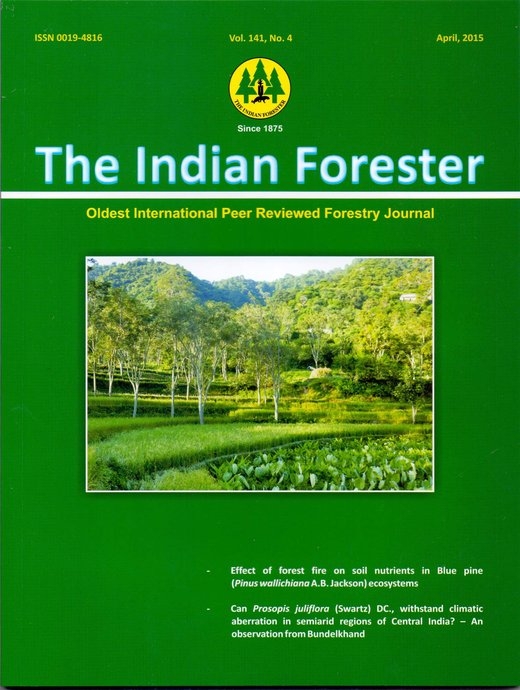Traditional Uses of Medicinal Plants of Cooch Behar and Jalpaiguri Districts of West Bengal, India
DOI:
https://doi.org/10.36808/if/2015/v141i4/68934Keywords:
Medicinal Plants, Traditional Healthcare System, North Bengal, Cooch Behar and Jalpaiguri.Abstract
An ethno-botanical survey was carried out in Cooch Behar and Jalpaiguri districts of North Bengal region of West Bengal, India during the period of October 31 - November 8, 2012. The present survey has revealed 43 species of medicinal plants largely, used by the natives in these districts. These plant species are used to cure various diseases/ailments as medicines in their day to day life. This plant wealth was conserved by the natives in different ways such as in their house compound/ kitchen gardens/ dooryards/ backyards as medicinal and ornamental plants. During the survey, it was observed that medicinal plants and related ethonbotanial information was declining very fast due to change in their life style, unawareness and lack of interest of new generation. The surveyed districts of North Bengal region, warrants conservation in order to preserve the medicinal plant wealth and related traditional health care system.References
Arya K. R. (2002). Traditional uses of some common plants in indigenuous folklore of Dronagiri, a mythic hill of Uttaranchal. Indian J. Traditional Knowledge, 1(1) 81-86.
Dahanukkar S. and Thatte U. (2000). Ayurveda Revised. Popular Prakashan, Mumbai, 3rd Edition.
Dash B. and Sharma B. K. (2001). Charak Samhita. Chaukhamba Sanskrit Series Office, Varanasi, India,7th Edition.
Dikshit V. K. (1999). Export of Medicinal Plants from India: Need for Resource Management. Biodiversity-North India Perspective: Peoples Participation in Biodiversity Conservation B. Kharbuli, H. Syem and H. Kayang. NEBRC, North Eastern Hill University, Shillong, pp 85-88.
Gupta R. and Chadha K.L. (1995). Medicinal and Aromatic Plants in India. In: Advances in Horticulture, Medicinal and Aromatic Plants. Malhotra Publishing House, New Delhi, pp1-14.
Hooker J. D. (1989). The Flora of British India. Vol. 1-7. London, L Reeve & Co.
Kala C.P. and Sajwan B.S. (2007). Revitalizing Indian Systems of Herbal Medicine by the National Medicinal Plants Board Through Institutional Networking and Capacity Building. Current Science, 93(6).
Kala C.P. (2000). Status and Conservation of Rare and Endangered Medicinal plants in the Indian trans-Himalaya. Conservation Biology, 93:371-379.
Kala C.P. (2005). Indigenous Uses, Population Density, and Conservation of Threatened Medicinal Plants in Protected Areas of the Indian Himalayas. Conservation Biology, 19:368-378.
Kanjilal U.N., Kanjilal P.C., De R.N. and Das A. (1982). A Flora of Assam. Vol.III & IV. Avon Book Company, Delhi-6.
Kurupusamy S., Rajsekaran K. and Karmegam M.(2002) Evaluation of phytomedicines from street herbal vendors in Tamil Nadu, South India Indian J. Traditional Knowledge,1:26-39.
Laloo R.C., Kharlukhi L., Jeeva S. and Mishra B.P. (2006). Status of Medicinal Plants in the Disturbed and Undisturbed Sacred Forest of Meghalaya. Current Science, 90(2): 225-232.
Myers N., Mittermeier R.A., Mittermeier C.G., da Fonseca G.A. and Kent J. (2000). Biodiversity Hotspots for Conservation priorities. Nature, 403:853-856.
Mehta P.S., Bhatt K.C., and Kumar Dinesh (2007). Studies on medicinal and aromatic plants used by the local inhabitants and their conservation status in Kumaun Himalaya. Eco. Research Journal of Bio-Science, 6(1&2):38-52.
Mukhopadhyay S. (1996). Conservation, Protection and Biodiversity of Medicinal Plants (eds Gautam P.L. et al). Indian Society for Plant Genetic Resources, NBPGR campus, New Delhi, pp 15-28.
Oostermeijer J.G.B., Luitjen S.H. and Nijs J.C.M. (2003). Inte89-398.
Pareek S.K. (1996). Medicinal Plants in India: Present Status and Future Prospects. Prospects of Medicinal Plants (eds Gautam P.L. et al). Indian Society for Plants Genetic Resources, NBPGR campus, New Delhi. pp 5-14.
Planning commission. (2000). Report of the Task Force on Conservation and Sustainable use of Medicinal Plants. Planning commission, Government of India.
Rocheleau D., Wochira K., Malarate L. and Wanjohi B.M. (1989), Farmers First, 14-24. Intermediate Technology Publisher, London U.K.
Singh H.B. (2000), Alternative Source for some conventional drug plants of India.In: Ethnobotany and medicinal plants of Indian Subcontinent. (Maheshwari J.K. eds). Scientific Publishers, Jodhpur, India, pp 63-78.
Yonzone R., Rai S.and Bhujel R.B. (2012). Genetic Diverisity of Botanical and Medicinal Plants Resources of Darjeeling Dstrict, West Bengal, India, IJAPR, January 3(1):713-729.
Downloads
Downloads
Published
How to Cite
Issue
Section
License
Unless otherwise stated, copyright or similar rights in all materials presented on the site, including graphical images, are owned by Indian Forester.





